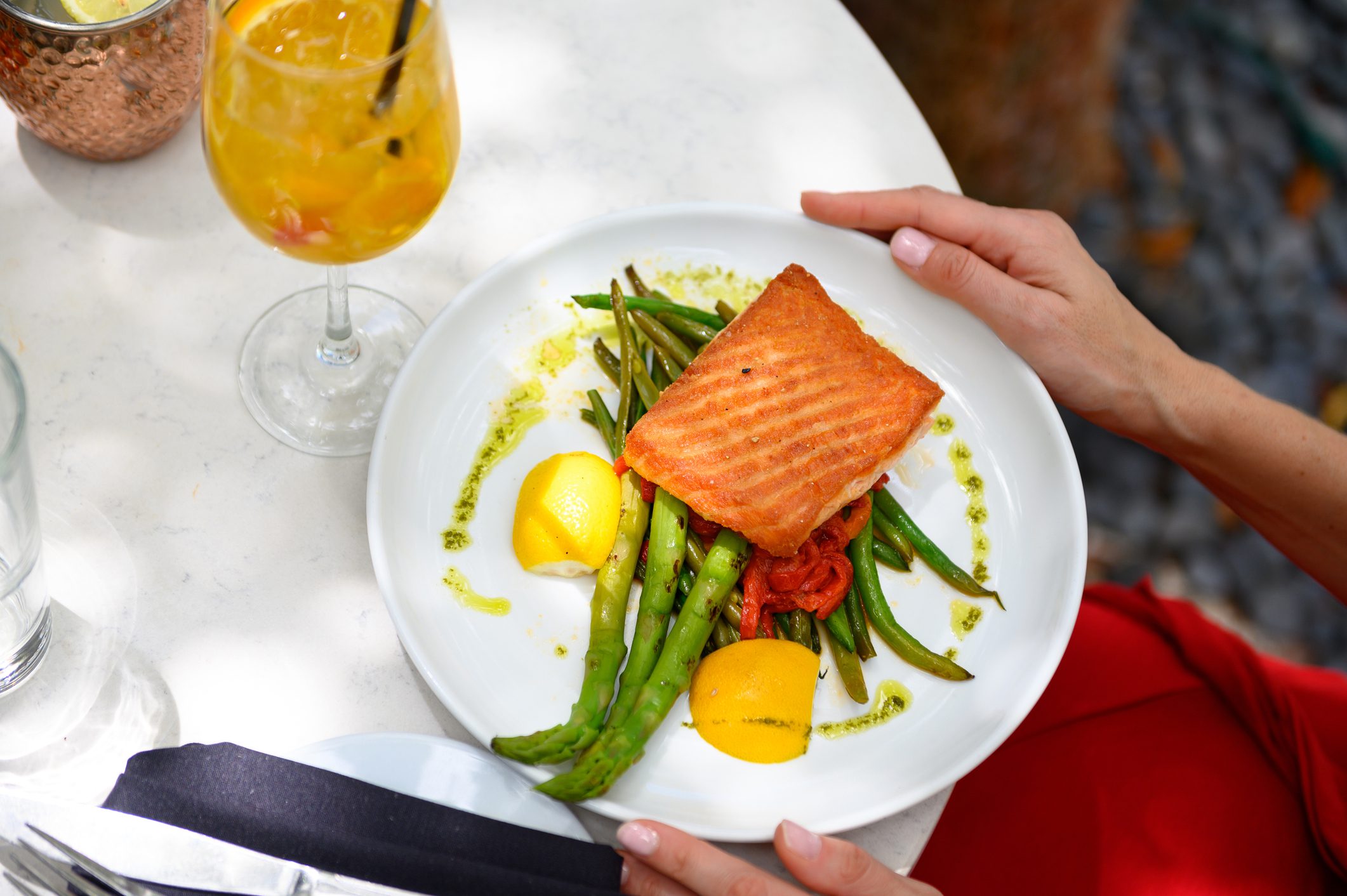Let’s say you just ate a grass-fed steak along with lots of non-starchy veggies and half a sweet potato.
Your body will break down carbohydrates and protein into glucose, which becomes its predominant fuel source. In other words, you will be a sugar burner after that meal.
Flash forward to the next morning. You had closed the kitchen after dinner and pushed breakfast forward, creating a nice 12-14 hour overnight fast.
By that point, you’re not running on glucose. You haven’t had any incoming food in at least 12 hours, and your glycogen (stored glucose) levels have probably been depleted, too.
When that happens, your body can dip into its stored fat, which becomes its primary fuel. You become a fat burner.
What Is Metabolic Flexibility?
You want to be both a sugar and fat burner, according to your body’s needs.
To do that, your body needs to be flexible enough to utilize both fat and sugar as fuel, according to its needs.
We call this adaptive ability metabolic flexibility.
“Metabolic flexibility is the body’s ability to adapt and use whatever fuel is available to it,” says Will Cole in Intuitive Fasting. “If you’ve eaten recently, that fuel is glucose (the sugar that’s in your blood). If it’s been a while since your last meal (or all your blood glucose has been used up), that fuel is stored fat.”
The word metabolism gets tossed around a lot. When I use the word here, I’m talking about how your body adjusts to different fuels coming in. Flexibility is key for a healthy metabolism. When your body is metabolically flexible, it can easily shift gears between glucose and fat as needed.
“Someone with great metabolic flexibility can burn carbs when they eat them,” says Mark Sisson. “They can burn fat when they eat it (or when they don’t eat at all). They can switch between carbohydrate metabolism and fat metabolism with relative ease.”1
Metabolic flexibility has its roots in exercise. When you exercise intensely, your energy demands change, and your body has to match that fuel availability.2
Like a hybrid car, metabolic flexibility allows you to move between fuel sources to get the biggest metabolic bang for your buck.
“Our ancestors needed metabolic flexibility to survive,” says Alan Christianson, ND, in The Metabolism Reset Diet. “When food wasn’t readily available, they could survive on what they’d stored for a time by breaking down fat to use as fuel.”
Today, of course, food is readily available. If you’re snacking throughout the day, you’ve got a steady supply of fuel coming in—most likely as sugar. Your body has absolutely no reason to dip into its fat stores.
As a result, you may be metabolically inflexible. As Cole says:
“[M]any of us currently rely almost entirely on [sugar] to fuel us and, as a result, our cells have lost their ability to quickly and efficiently switch from using sugar to using fat for fuel. In other words, we’ve lost our metabolic flexibility and, therefore, our ability to maintain consistent energy levels, brainpower, and appetites.”
Signs You’re Metabolically Inflexible
- You’re hungry more often—and not for healthy stuff, either.
- You struggle with cravings.
- Weight loss becomes a huge challenge
- Research shows you’re more prone to metabolic syndrome, type 2 diabetes, cancer, and other diseases.3
- You’re often more likely to struggle with symptoms like brain fog, digestive issues, and fatigue.
- Intermittent fasting? Forget it… You’re going to be a hangry monster.
That’s the sugar-burning mode. When your body doesn’t have access to stored fat, weight loss comes to a grinding halt.
The good news: You have the power to become more metabolically flexible, starting with your next meal.
5 Ways to Become Metabolically Flexible
You can teach your body to be more metabolically flexible so that you effortlessly use both glucose and fat as fuel.
Great sleep, the right kind of exercise, managing stress levels, and getting the right nutrients all go a long way here. To be and stay metabolically flexible, these are all critical.
But the best place to become more metabolically flexible is at the end of your fork. Here are five ways how.
1. Eat by the Plate
When you eat a balanced plate every three to four hours, you steady your blood-sugar levels. As a result, you won’t need to snack, plus you teach your body to better access fuel sources when it needs them.
You can optimize metabolic flexibility with this trifecta at every meal:
- Protein. When you eat enough protein from sources like grass-fed beef, wild-caught seafood, nuts, and seeds, your pancreas responds by releasing the hormones glucagon and insulin, which help stabilize blood sugar. As a result, you avoid cravings and stay fuller longer.
- Healthy fats. Eating smart fats teaches your body to better utilize fat, including stored body fat. One of my favorite fats is coconut, which provides healthy medium-chain triglycerides (MCTs) to help turbocharge your body’s metabolism.
- Fiber. Dietary fiber can support and balance the trillions of gut bacteria, reduce inflammation, and steady your appetite—which is a surefire formula to be metabolically flexible. Aim for 50 grams of fiber daily. Do this gradually, adding five or so grams till you meet your goal, and be sure to drink enough water to compensate.
2. Incorporate Intermittent Fasting
To be an efficient fat burner, when you eat is as important as what you eat. And to do intermittent fasting well, you need to be metabolically flexible, otherwise, you are going to be irritable, cranky, and constantly craving sugar—because sugar is your body’s primary fuel source.
When you’ve been eating by the plate for a few weeks, you’ve trained your body to better use fat as fuel.
As a result, going three to four hours between meals becomes a breeze. And going for longer periods without food starts to feel much easier.
If you’re a fasting newbie, I recommend starting with an overnight fast. Here are three simple ways to do that:
- Eat by the plate for dinner.
- Close the kitchen for the evening. That means no 11 pm snack raid! If you’re hungry at night, have a glass of water before bed.
- Break your fast the next morning with a loaded smoothie, around 9 or 10 am (see #3.)
You’ll effortlessly create a 12-14 hour fasting window, and you’ll be sleeping most of that time!
3. Start Your Day With a Loaded Smoothie
Just as important as how you fast is how you break your fast.
Start off your day with a high sugar-impact muffin or cereal and you’ve given your body a clear agenda to burn sugar as fuel all day—not fat.
To be metabolically flexible, your body needs to use that protein-fat-fiber trifecta I mentioned above as fuel.
A loaded smoothie is the best way to break your fast, boost your metabolism, and make you an all-day fat burner. With a smoothie, you can pack lots of nutrient-dense ingredients into a grab-and-go meal.
Need some inspiration? This Matcha Blueberry Smoothie combines the power of green tea with other metabolism boosters including coconut milk, blueberries, and avocado.
Want more loaded smoothie ideas? I’ve got over 60 delicious, easy-to-make recipes in this FREE Smoothie Guide.
4. Support Your Liver
According to Christianson, your ability to adjust how your body utilizes fuel depends on liver function.
When excess sugar creates a burden on your liver, you store it as fat. And while liver support might require specific nutrients you may need to supplement with, food is a great place to start.
Research shows that cruciferous vegetables like Brussels sprouts can boost levels of the liver’s detoxification enzymes.4 This Roasted Brussels Sprouts & Bacon recipe makes a tasty way to support liver health!
5. Optimize Your Gut Health
Your trillions of gut bacteria are the gatekeepers of your mood, inflammation, and metabolism.
Even if you’ve been pounding them with processed food for years and ignoring the consequences, they’ll respond fast when you give them clean, whole foods because they’re designed to run on the good stuff. They’re literally hungry for it.
When those bacteria aren’t working properly, you’re more likely to crave sugar, making you more metabolically inflexible in the bargain.
You can go a long way toward healing the gut by pulling the seven highly reactive foods I talk about in The Virgin Diet along with incorporating an overnight fast.
I’ve deep-dived into leaky gut and other gut issues in my book, including an extensive protocol to heal your gut and optimize metabolic flexibility.
The best place to start healing your gut is, yep, the end of your fork! Learn about seven of my favorite gut-loving foods here.
The views in this blog by JJ Virgin should never be used as a substitute for professional medical advice. Please work with a healthcare practitioner concerning any medical problem or concern. The information here is not intended to diagnose, treat, or prevent any disease or condition. Statements contained here have not been evaluated by the Food and Drug Administration.
*These statements have not been evaluated by the Food and Drug Administration. This product is not intended to diagnose, treat, cure, or prevent any disease.
References
- https://www.marksdailyapple.com/definitive-guide-to-metabolic-flexibility/
- Goodpaster BH, Sparks LM. Metabolic Flexibility in Health and Disease. Cell Metab. 2017 May 2;25(5):1027–1036. doi: 10.1016/j.cmet.2017.04.015. PMID: 28467922; PMCID: PMC5513193.
- Smith RL, Soeters MR, Wüst RCI, Houtkooper RH. Metabolic Flexibility as an Adaptation to Energy Resources and Requirements in Health and Disease. Endocr Rev. 2018 Aug 1;39(4):489–517. doi: 10.1210/er.2017–00211. PMID: 29697773; PMCID: PMC6093334.
- Robbins MG, Hauder J, Somoza V, Eshelman BD, Barnes DM, Hanlon PR. Induction of detoxification enzymes by feeding unblanched Brussels sprouts containing active myrosinase to mice for 2 wk. J Food Sci. 2010 Aug 1;75(6):H190–9. doi: 10.1111/j.1750–3841.2010.01713.x. PMID: 20722931.





